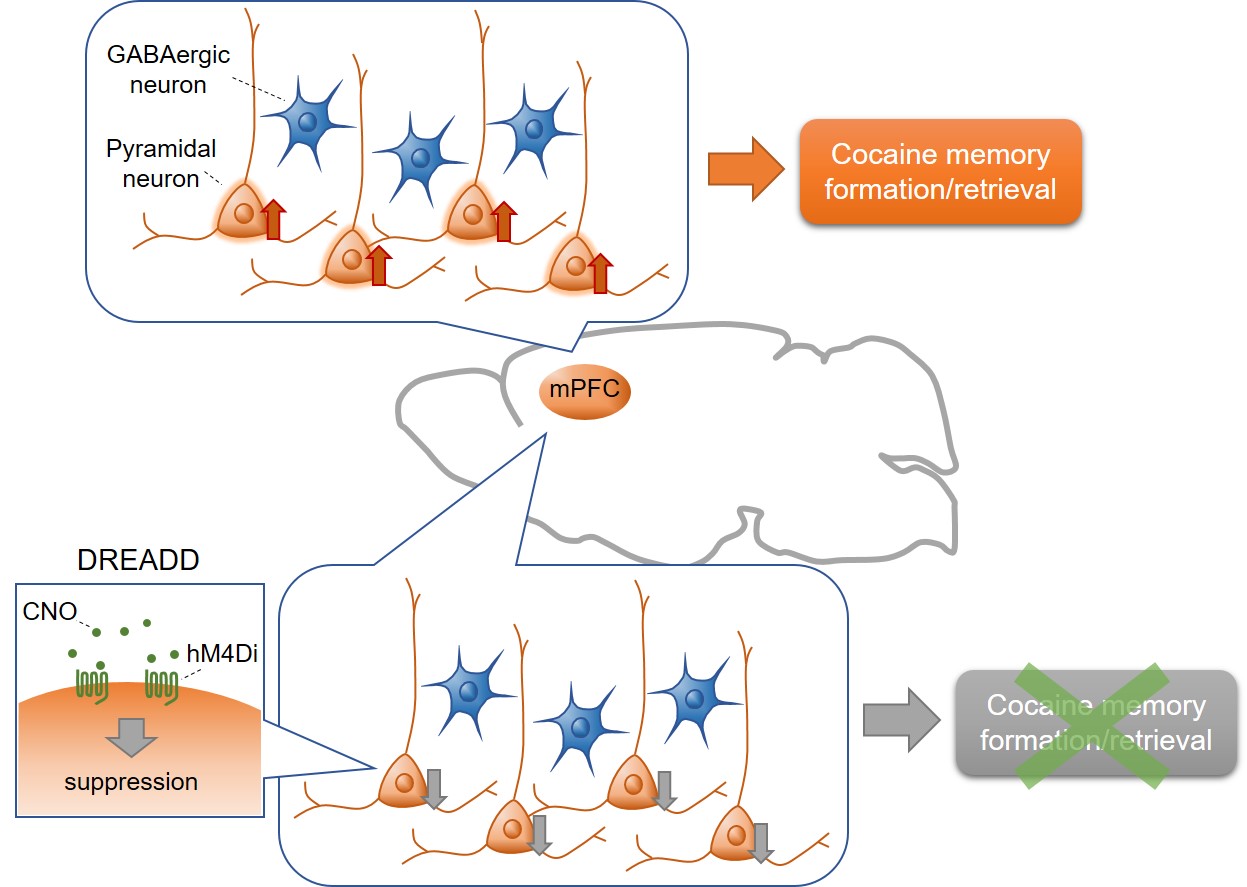Abstract:
A Japan-based research team led by Kanazawa University has revealed neuronal mechanisms underlying the formation and retrieval of cocaine use-associated memories. Their research sheds light on how drug addiction develops and reveals pathways that can be exploited for the development of strategies to treat cocaine addiction.
[Background]
The environmental context in which addicts experience the rewarding effects of cocaine can readily elicit cocaine-associated memories. These memories persist long after abstinence and trigger cocaine-craving and consumption. Thus, understanding the neuronal mechanisms underlying the formation and retrieval of cocaine-associated memories is critical for developing treatment for cocaine addiction. The medial prefrontal cortex (mPFC), a brain region associated with recognition, working memory and attention, has been suggested to play a critical role in drug addiction. Lesions to the mPFC disrupt cocaine-associated memories; however, it is unclear whether the mPFC is associated with the formation and/or retrieval of cocaine-associated memories. Thus, inactivation of the mPFC at specific times, either during the memory formation or retrieval phase, is necessary to address the distinct roles of the mPFC. Likewise, inactivation of specific mPFC cell types will permit elucidation of the role of discrete neuronal subpopulations (for example, mPFC glutamatergic pyramidal or GABAergic neurons) in the development of cocaine-associated memories. However, because of technical limitations, causal relationships between neuronal activity and memory formation/retrieval remain unclear.
[Results]
The present study was conducted by a collaboration of researchers from Kanazawa, Hokkaido, Okayama, Niigata, Nagoya, Tsukuba, and Kyoto Universities, Japan. The experiments were performed at Kanazawa University.The study employed a cocaine-induced conditioned place preference (CPP) test, a Pavlovian conditioning paradigm, combined with ‘designer receptors exclusively activated by designer drugs’ (DREADD) technology. The CPP test involves administration of cocaine to animals in a specific context; the animals learn to associate the rewarding properties of cocaine with this context, resulting in the formation of cocaine-associated memories. In the test, the animals retrieve the cocaine-associated memory when placed in the cocaine-administered context and exhibit preference for the context. Wild-type C57BL/6J mice received bilateral intra-mPFC infusion of an adeno-associated virus (AAV) expressing inhibitory DREADD (hM4Di) under control of the CaMKII promotor to selectively suppress mPFC glutamatergic pyramidal neurons. GAD67-Cre mice received bilateral intra-mPFC infusion of a Cre-dependent AAV expressing hM4Di to specifically silence GABAergic neurons. hM4Di is an artificial receptor that is selectively activated by clozapine N-oxide (CNO), which leads to inhibition of neurons expressing hM4Di. Chemogenetic suppression of mPFC glutamatergic pyramidal neurons by injecting CNO significantly attenuated both the acquisition and expression of cocaine CPP. In contrast, suppression of mPFC GABAergic neurons affected neither the acquisition nor expression of cocaine CPP.
[Significance and future prospects]
The present study demonstrates that the chemogenetic suppression of mPFC glutamatergic, but not GABAergic, neurons inhibits both the acquisition and expression of cocaine CPP. To our knowledge, this is the first direct evidence showing that activation of glutamatergic pyramidal neurons in the mPFC is causally involved in both the formation and retrieval of cocaine-associated memories. Therefore, mPFC pyramidal neurons are a potential therapeutic target for the treatment of drug addiction.

Figure 1.
Schematic summary of this study. Activation of mPFC pyramidal (excitatory), but not GABAergic (inhibitory), neurons leads to the formation and retrieval of cocaine-associated memories (upper). Cell-type specific suppression of mPFC pyramidal neurons by DREADD technology inhibits the formation and retrieval of cocaine-associated memories (lower).
Article
Glutamatergic neurons in the medial prefrontal cortex mediate the formation and retrieval of cocaine-associated memories in mice
Journal: Addiction Biology
Authors: Tong Zhang, Junko Yanagida, Hironori Kamii, Shintaro Wada, Masaki Domoto, Hitoki Sasase, Satoshi Deyama, Takeshi Takarada, Eiichi Hinoi, Kenji Sakimura, Akihiro Yamanaka, Takashi Maejima, Michihiro Mieda, Takeshi Sakurai, Naoya Nishitani, Kazuki Nagayasu, Shuji Kaneko, Masabumi Minami, Katsuyuki Kaneda
DOI: 10.1111/adb.12723
Funder
Grant‐in‐Aid for Scientific Research (B) from the Japan Society for the Promotion of Science, Grant/Award Number: 18H02523; Grant‐in‐Aid for Scientific Research (C) from the Japan Society for the Promotion of Science, Grant/Award Numbers: 15K06765 and 18K06520; The Naito Foundation (K.K.); Smoking Research Foundation (K.K.); Hoansha Foundation (K.K.)



 PAGE TOP
PAGE TOP